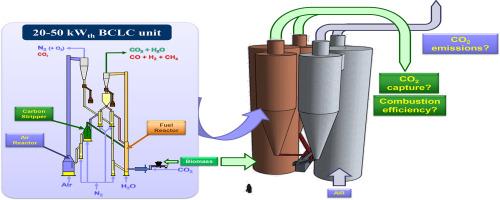Assessment of the potential of biomass chemical looping combustion with CO2 capture from experimental results at the 20 kWth scale with olive stone
IF 5
Q2 ENERGY & FUELS
引用次数: 0
Abstract
The bioenergy with CO2 Capture and Storage (BECCS) concept has the potential for the carbon dioxide removal (CDR) from the atmosphere. Among the negative emissions technologies (NETs), Chemical Looping Combustion (CLC) has low economic and energetic costs due to the inherent CO2 capture by splitting the combustion in fuel and air reactors. The fuel combustion happens in the fuel reactor, where CO2 is concentrated and separated from air. In this work, the combustion of olive stone is performed in a CLC unit at the 20 kWth scale using a highly reactive iron ore. The tests analyse the effect on the combustion efficiency and the CO2 capture of the main operating conditions: reacting temperature (800-970 °C), oxygen carrier-to-fuel ratio (ϕ=1-3) and specific solids inventory (140-720 kg/MWth). Tests at a lower scale (6 kWth) evaluate the effect of some design parameters. A total of 60 h of olive stone combustion were performed. No relevant differences on the CO2 capture were observed among these scales. Full combustion was not achieved due to the high volatile content of the biomass and the uncompleted oxidation of char gasification products, but the combustion degree was improved at the highest scale due to the proper development of the characteristic fluid dynamic of a circulating fluidized bed. A cross-effect was observed between CO2 capture and combustion efficiency: the later decreased as the first increased due to the higher char conversion. CO2 capture values above 90 % may be feasible with oxygen demand values around 15 % operating at fuel reactor temperatures above 950 °C and specific solids inventory values about 300-400 kg/MWth.

从20千瓦时规模的橄榄石实验结果评估生物质化学环燃烧与CO2捕集的潜力
具有二氧化碳捕获和储存(BECCS)概念的生物能源具有从大气中去除二氧化碳(CDR)的潜力。在负排放技术(NETs)中,化学环燃烧(CLC)具有较低的经济和能源成本,因为它通过在燃料和空气反应器中分裂燃烧来捕获二氧化碳。燃料燃烧发生在燃料反应堆中,在那里二氧化碳被浓缩并与空气分离。在这项工作中,橄榄石的燃烧是在20千瓦时规模的CLC装置中使用高活性铁矿石进行的。测试分析了主要操作条件对燃烧效率和二氧化碳捕获的影响:反应温度(800-970°C),氧载体与燃料比(ϕ=1-3)和比固体库存(140-720 kg/MWth)。在较低规模(6千瓦时)的试验评估了一些设计参数的影响。共进行了60小时的橄榄石燃烧。各尺度间CO2捕集量无相关差异。由于生物质挥发分含量高,焦炭气化产物氧化不完全,未实现充分燃烧,但由于循环流化床特性流体动力学的适当开发,燃烧程度在最高尺度上得到了提高。在CO2捕获和燃烧效率之间观察到交叉效应:由于较高的焦炭转化率,后者降低,而前者增加。在燃料反应堆温度高于950°C,比固体库存值约为300-400 kg/MWth的情况下,需氧量约为15%,二氧化碳捕获值高于90%是可行的。
本文章由计算机程序翻译,如有差异,请以英文原文为准。
求助全文
约1分钟内获得全文
求助全文

 求助内容:
求助内容: 应助结果提醒方式:
应助结果提醒方式:


